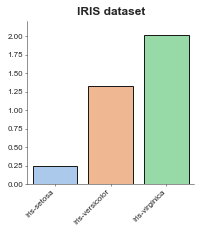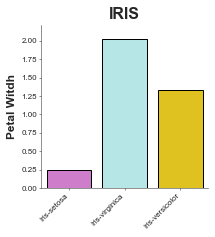Barchart¶
Barchart options:
df: pd.DataFrame,
x: object --> string column name of the violinplot values in the DF for the X
y: object --> string column name of the violinplot values in the DF for the Y
title='' --> string title
xlabel='' --> string x label
ylabel='' --> string y label
hue=None --> column you want to colour by
order=None --> order of your values
hue_order=None,
figsize=(3, 3),
title_font_size=12,
label_font_size=8,
title_font_weight=700,
errwidth=0,
linewidth=1,
edgecolor="k",
config={}
Config options = any of the parameters with the same name but with in a dictionary format instead, and also includes default parameters for the visualisation such as the font family and font.
Example config:
config={'palette': ['red', 'yellow', 'pink'],
'figsize':(4, 5), # Size of figure (x, y)
'title_font_size': 16, # Size of the title (pt)
'label_font_size': 12, # Size of the labels (pt)
'title_font_weight': 700, # 700 = bold, 600 = normal, 400 = thin
'font_family': 'sans-serif', # 'serif', 'sans-serif', or 'monospace'
'font': ['Tahoma'] # Default: Arial # http://jonathansoma.com/lede/data-studio/matplotlib/list-all-fonts-available-in-matplotlib-plus-samples/
}
Reading in DF¶
[1]:
import pandas as pd
from sciviso import Barchart, Boxplot, Heatmap, Histogram, Scatterplot, Violinplot, Volcanoplot, Line
import matplotlib.pyplot as plt
df = pd.read_csv('iris.csv')
x = 'sepal_width'
numeric_cols = ['sepal_width', 'sepal_length', 'petal_length', 'petal_width']
df
[1]:
| sepal_length | sepal_width | petal_length | petal_width | label | |
|---|---|---|---|---|---|
| 0 | 5.1 | 3.5 | 1.4 | 0.2 | Iris-setosa |
| 1 | 4.9 | 3.0 | 1.4 | 0.2 | Iris-setosa |
| 2 | 4.7 | 3.2 | 1.3 | 0.2 | Iris-setosa |
| 3 | 4.6 | 3.1 | 1.5 | 0.2 | Iris-setosa |
| 4 | 5.0 | 3.6 | 1.4 | 0.2 | Iris-setosa |
| ... | ... | ... | ... | ... | ... |
| 145 | 6.7 | 3.0 | 5.2 | 2.3 | Iris-virginica |
| 146 | 6.3 | 2.5 | 5.0 | 1.9 | Iris-virginica |
| 147 | 6.5 | 3.0 | 5.2 | 2.0 | Iris-virginica |
| 148 | 6.2 | 3.4 | 5.4 | 2.3 | Iris-virginica |
| 149 | 5.9 | 3.0 | 5.1 | 1.8 | Iris-virginica |
150 rows × 5 columns
[2]:
barchart = Barchart(df, x='label', y='petal_width', title='IRIS dataset')
barchart.plot()
plt.show()

[6]:
# barchart = Barchart(df: pd.DataFrame, x: object, y: object, title='', xlabel='', ylabel='', hue=None, order=None,
# hue_order=None, figsize=(3, 3), title_font_size=12, label_font_size=8, title_font_weight=700,
# errwidth=0, linewidth=1, edgecolor="k", config={})
# Config options = any of the parameters with the same name but with in a dictionary format instead
import seaborn as sns
from matplotlib import rcParams
barchart = Barchart(df=df, x='label', y='petal_width', title='IRIS', xlabel='', ylabel='Petal Witdh',
order=['Iris-setosa', 'Iris-virginica', 'Iris-versicolor'],
errwidth=0,
linewidth=1,
edgecolor="black",
# You could also pass these as individual parameters, but it's easier to set as a dictionary
# also, then you can re-use it for other charts!
config={'palette': ['orchid', 'paleturquoise', 'gold'],
'figsize':(3, 3), # Size of figure (x, y)
'title_font_size': 16, # Size of the title (pt)
'label_font_size': 12, # Size of the labels (pt)
'title_font_weight': 700, # 700 = bold, 600 = normal, 400 = thin
'font_family': 'sans-serif', # 'serif', 'sans-serif', or 'monospace'
'font': ['Tahoma'] # Default: Arial # http://jonathansoma.com/lede/data-studio/matplotlib/list-all-fonts-available-in-matplotlib-plus-samples/
})
barchart.plot()
plt.savefig('barchart.png', dpi=300) # .png, .pdf, .jpg
plt.savefig('barchart.svg', bbox_inches='tight') # .png, .pdf, .jpg
